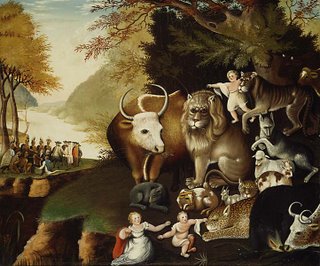The Peaceable Kingdom

During the early years of the 19th century, while the serious artists who led the Romantic movement in Europe plied their predilection for the unattainable by revealing the unique and the unexpected in countless settings, each new composition setting the stage for another depiction of an extreme -- some so-called primitive artists in America, Edward Hicks being the best known among them, were exploiting repetition along something approaching Warholian lines to reach their audiences.
Hicks (who was born on this date in 1780 in Attleboro, Pennsylvania) was originally a Bucks County sign painter by trade, but he abandoned his work to become a Society of Friends preacher. Perhaps in an effort to harmonize his guilty pleasure for painting with his Quaker asceticism, Hicks compulsively painted more than 100 versions of his visualization of the prophecy of Isaiah 11:6-9, The Peaceable Kingdom (1830s-40s) -- all of which show in Hicks' charming, childlike hand the lion lying down with the lamb, with William Penn striking his legendary 1682 treaty with the Delaware chiefs at Shackamaxon for the right to live and worship in Pennsylvania in the background, a literal and thoroughly popularized interpretation of the prediction that all the men and beasts shall live together in peace. Hicks copied his depiction of Penn and the Delawares, incidentally, from another famous painting, Benjamin West's Penn's Treaty with the Indians, 1772, itself a kind of "Campbell's Soup can" of its day.
He died on August 23, 1849 in Newtown, Pennsylvania, and notwithstanding the popularity of his paintings, at Hicks' funeral, 3,000 mourners gathered to lament the loss of a great preacher.
Labels: Painting and Sculpture





0 Comments:
Post a Comment
Subscribe to Post Comments [Atom]
<< Home